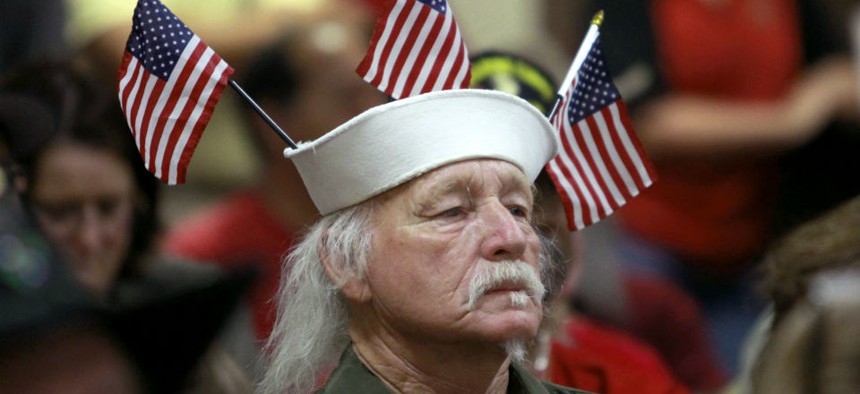
Vietnam veteran Louis Albin, who served in the U.S. Navy, listens during a town hall meeting at American Legion Post 1 on Monday, June 9, 2014, in Phoenix concerning health-care issues at the Phoenix VA facilities. Ralph Freso/AP
One Thing That Is Going Right for Veterans
More Iraq and Afghanistan veterans are finding jobs, but the unemployment rate could easily creep back up as more soldiers come home.
Every day seems to bring more bad news for veterans. But amid the ever-growing scandal at the Veterans Affairs Department, there is one thing going right: Many more veterans are getting jobs.
The unemployment rate for Iraq and Afghanistan veterans, which now stands at 5.3 percent, is at its lowest point in nearly six years. Unemployment levels for these newer veterans peaked at 15.2 percent in 2011.
And this follows a larger trend within the overall vets population. Unemployment rates for all veterans dropped to 5 percent in May, down from a peak of 9.8 percent in 2011, according to the Bureau of Labor Statistics.
"It's important to recognize this continuing downward trend for vets overall, and particularly for post-9/11 vets," said Jacqueline Maffucci, the research director for the Iraq and Afghanistan Veterans of America advocacy group. "But we also can't declare victory just yet."
A key reason for the dramatic improvement is that nonprofits have poured more resources into job programs for veterans. The efforts include helping veterans find work that matches their skills and teaching them to translate their military experience into civilian-friendly terms on their résumés.
"All of these hiring programs have worked to some degree. ... They result in the hiring of tens of thousands, if not hundreds of thousands, of these men and women," said Phillip Carter, a senior fellow at the Center for a New American Security, a defense think tank.
Meanwhile, dozens of companies have teamed up to pledge more than 1 million jobs for veterans, including such major corporations as Wal-Mart Stores and JPMorgan Chase.
But with more jobs pledged than there are unemployed veterans from the Iraq and Afghanistan wars to fill them, why aren't all of these veterans now in the workforce?
"There's still not a perfect fit between these jobs and the veterans seeking jobs. … And there's also a natural level of unemployment and friction in the transition process that will always be there," Carter said.
Dan Goldenberg serves as executive director for the Call of Duty Endowment, which offers financial support to job-placement programs that help veterans find work. He describes the issue of out-of-work veterans as a problem of supply and demand. The supply side: Veterans have to be ready to join the civilian job market. The demand? Advocates worry there is a gap between well-intentioned CEOs pledging to bring more veterans on board and the person who makes the final hiring decision.
"They really struggle, because the people pulling the trigger are hiring managers," Goldenberg said. "… [Hiring managers could wonder]: 'Do they have enough of the right experience, or [do they have] combat-related baggage? This veteran doesn't look like the type of person I'm used to hiring.… Now you're asking me to take on a project.' That's what we really worry about a lot, because the stories being told about veterans are all about damaged goods."
More than 80 percent of the 69 companies surveyed by the Center for New American Security in a 2012 study named two or more challenges to hiring veterans. Almost 60 percent pointed to challenges translating military skills to a civilian career as well as to a negative perception of veterans. Case in point: the flood of veteran suicide and mental-health stories that flooded media after the Fort Hood shooting.
"I think that our society has proven time and time again that stereotypes are dangerous and wrong and shouldn't be applied to a large group of people," said Lauren Augustine, a legislative associate with the Iraq and Afghanistan Veterans of America.
The federal government has its own transition assistance program, known as TAP, to help veterans ease back into the civilian job market. But some argue that TAP—an interagency partnership including the Labor, Defense, and Veterans Affairs departments—doesn't go far enough.
The latest iteration of TAP—rolled out in fiscal 2013—is mandatory for all soldiers before they leave the military. It includes a three-day workshop with the Labor Department in which soldiers get tips for writing a résumé and going to a job interview.
Soldiers also meet with the VA to discuss potential disability and education benefits—including the Post-9/11 GI Bill, which helps veterans afford college. And TAP requires service members to create a transition plan, in which they must outline a strategy to reach their goals after leaving the military.
But critics say there is still more work that can be done to better prepare troops.
"The TAP program has made some modest improvements.… It's not as significant as these jobs pledges and these public-private partnerships," Carter said. "… The fundamental flaw with TAP is that you can't undo two years or four years or 20 years of the military with one week of PowerPoint."
The Pentagon could help soldiers adjust to working in the civilian world by allowing greater cooperation with outside organizations before they separate from the military, Carter said.
One example of this is at Joint Base Lewis-McChord near Tacoma, Wash., where service members can enroll in an array of apprenticeship programs across the country as they prepare to leave the military.
And more interaction with civilians before leaving the service could help bridge what veterans point to as a civilian-military divide. It could also help them balance their job expectations.
Jim Reed, who spent 27 years in the Army before retiring, said that he realized after getting out of the military that his seniority didn't carry over into his civilian job as a nurse anesthetist.
"I had ascended to kind of a midlevel management system....Then I get out, and there is none of that without relocating all over the place," he said. "... That was a bit of a tougher pill for me to swallow."
Despite the promising recent drop in unemployment, veterans advocates know they have to stay focused on finding jobs for those returning from service. They warn that veterans unemployment levels could easily spike again, as the month-to-month unemployment numbers for Iraq and Afghanistan have resembled something of a roller coaster.
That worry is compounded by the surge in veterans that is coming with the drawdown in Afghanistan, with approximately 20,000 troops being pulled out by the end of the year. And more service members could be forced out the military due to budget cuts over the next five years as well.
"We're really concerned about it," Goldenberg said. "... The economy is now going to see a different kind of veteran—one who had planned on a military career and—not through any fault of their own—is suddenly on the job market."
NEXT STORY: High Court Rules Public Workers Can Testify







